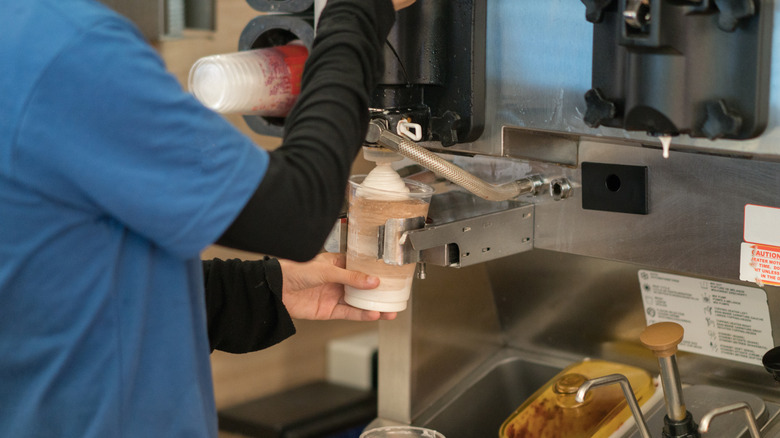The Gross Reality Of Soft Serve Ice Cream Machines
Hot summers provide the perfect environment for a cold treat — but you might want to think twice before reaching for that soft serve (which isn't considered ice cream). The reality of most soft-serve might be grosser: The truth is that the inside of those machines can be a hotbed for bacteria.
If you've ever had a tummy ache after eating a sundae from Mr. Softee, it might not be lactose intolerance — it might be the ice cream and the machine it came out of. In November 2017, Inside Edition published an exposé unpacking the food safety of soft-serve after an investigation by the outlet found traces of bacteria in nine out of 40 ice cream samples collected from locations around Seattle. The samples that tested positive indicated that the ice cream had higher-than-normal levels of coliform – an anaerobic bacteria that doesn't require oxygen to multiply.
Coliforms are found in drinking water, but they're also present in the digestive tracts of animals such as humans. By itself, coliform does not necessarily make someone sick but indicates not-so-sanitary conditions, and there are strains of E. coli that can cause serious illness.In 2005, NBC News reported over 120 people in Ohio got food poisoning after eating soft-serve at a local McDonald's. The health department determined that staphylococcus somehow contaminated the location's dairy mixture, and a machine malfunction allowed the bacteria to grow inside the soft serve machine.
Soft-serve machines must be cleaned daily to avoid health risks
Without regular maintenance and cleaning, soft-serve machines can get very gross very quickly. It's standard practice for restaurants serving up any kind of soft serve to clean their machines daily, dismantling the machine, thoroughly sanitizing each of the tiny pieces inside, and letting them air dry completely before reassembly.
An employee at a McDonald's location in Laplace, Louisiana, was fired from his job in July 2017 after posting photos of the ice cream machine's drip tray on Twitter, which was covered in black slime, indicating the tray collecting any excess ice cream had not been cleaned in some time (per HuffPost). The employee said managers were supposed to clean the drip tray every day, but claimed he never saw the manager at his location do this crucial chore. For example, the Vermont Agency of Agriculture (VAA) calls for at least two gallons of sanitizing solution when cleaning soft-serve machines, only after each corner has been thoroughly scrubbed with soap and hot water.
The process of cleaning these machines can take hours from start to finish when done properly. In an extreme case, the Washington State Department of Health reported in August 2023 that three people died, with several others hospitalized, after drinking listeria-contaminated milkshakes, which was blamed on the unhygienic ice cream machine at Frugals, a burger place in Tacoma, Washington. It was determined the machine had not been cleaned properly.
Soft serve safety is key
Nearly a decade prior, a 2015 scientific study by the Cambridge Journal of Epidemiology & Infection found that two hospital patients in Seattle were made even sicker after drinking the milkshakes from the hospital cafeteria, which were later found to have contained the potentially deadly Listeria. However, it was later found to be a manufacturer issue with the ice cream mix and not a problem with the machines.
Soft-serve ice cream mix is perishable and can become contaminated in all kinds of ways, from the wrong storage temperature to mishandling by workers. A 2016 study published in Frontiers in Microbiology found that bacteria, such as coliforms, could indicate whether dairy products had been exposed to unhygienic conditions and processing contamination post-pasteurization — but that testing needs to be more focused on specific strains of bacteria to be as accurate as possible. In terms of storage, the VAA calls for a pretty narrow temperature range for freezing, requiring restaurants to keep their ice cream mix at 40 degrees Fahrenheit or less as it can quickly develop more dangerous bacteria such as listeria and staphylococcus.
This is not to say you can't enjoy soft-serve this summer, but if you're really worried about it, you can easily make it at home or transform ice cream into soft serve rather than chasing after the ice cream truck. After all, half the fun of a hot summer day is enjoying a drippy cone with your favorite toppings.



